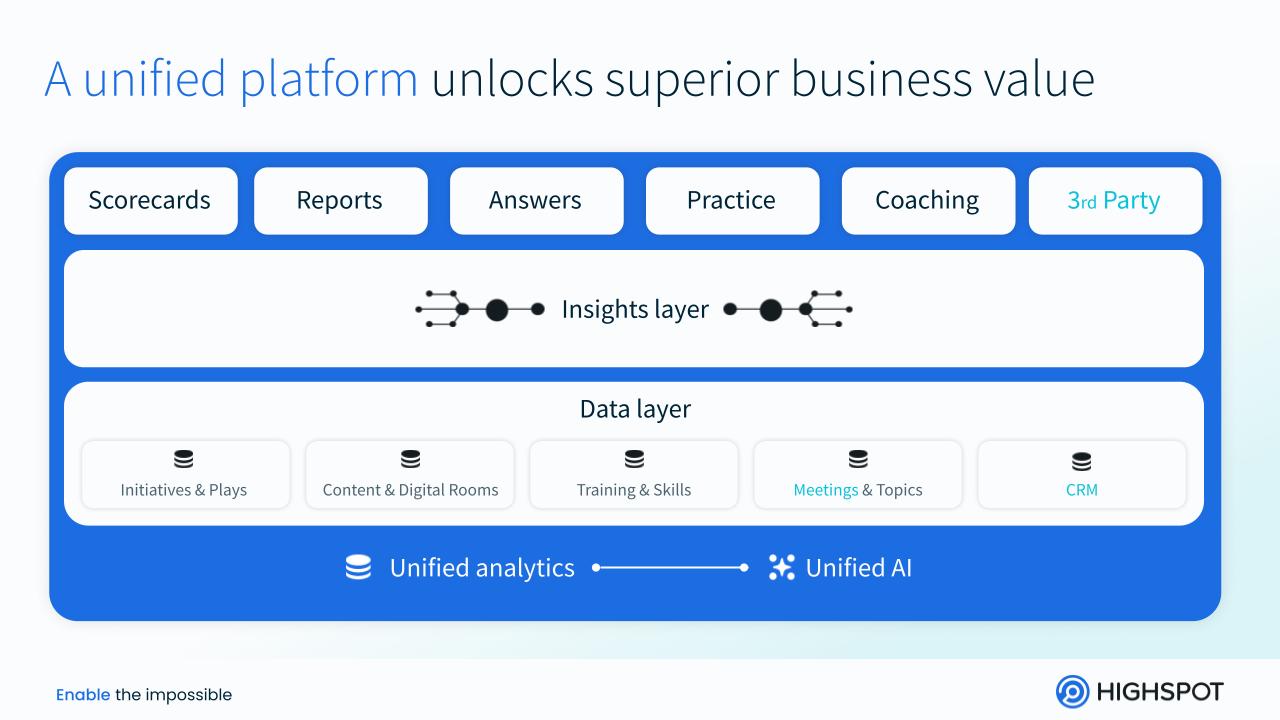We’re very excited about the opportunity to leverage AI to help sellers be more effective, and we’ve been investing heavily in many different ways to bring the power of this new technology to our customers. Our approach is based on two main principles:
- Generate uniquely useful insights
- Share insights through a wide range of experiences
Generate Uniquely Useful Insights
When it comes to AI, everything ultimately comes down to having the best data. We’ve all learnt that if you feed bad data to these systems, you’ll get the problems that any AI user has experienced – the AI will hallucinate and give you wonderfully authoritative sounding answers… that just happen to also be wrong. So a key question to challenge yourself with when you are implementing AI is, where can you feed it with great data and how can that let you help your users in compelling ways?
As a sales enablement platform, we have a unique set of data that isn’t available anywhere else. Depending on which features of Highspot they decide to leverage, our customers use the platform in many ways that generate useful data. We have highly curated content they put in the system because it is what they want their sellers to be using. They use us to share that content with customers and assess engagement. They configure the sales plays sellers are supposed to be running and the strategic initiatives the company depends on to grow their business. They build courses and identify key skills and competencies their sellers need to have. They put customer call recordings in the system that capture the actual engagement sellers have with customers. We unify all of that data into a single data model, which lets us combine different sources of knowledge to deliver key insights.
Take a simple example: we have a feature that lets users ask questions through a conversational interface. One of our users asked the question, “What is the best case study for financial services?” That seems like a pretty simple question on the face of it, but if you peel it back a bit, things get complicated. In this case, the user is really asking, “For sellers who are like me, look at customer engagements similar to the one(s) I’m currently working in financial services, find all the content that has been shared, figure out which of them are case studies, measure how effective those case studies were at engaging the customer and moving the deal forward, and share the top one or two with me”.
If you’re a North American seller to mid-tier banks on the East Coast, you aren’t going to use the same resources as a seller in France working with national or multi-national financial firms. And a case study itself can’t tell you if it is the best one – you need to look at which ones were shared with which customers, and what happened. It’s probably not enough to just look at whether that deal closed, because the distance from “I shared a case study with you in January” to “I closed a giant enterprise deal in December” makes that kind of conclusion pretty challenging. You want to look at outcomes that are closer to the event:
- Did they read the content?
- Did they share it with anyone else?
- Did the rep get a next meeting?
- Did the case study come up in a subsequent meeting?
- Did the deal move to the next stage?
These are outcomes that are much more directly connected to the item you shared with them.
This is just one example of how you need to combine many different kinds of data to come up with good answers to the questions sellers want to ask. The same goes for many other kinds of insights you want to use in various sales situations. Highspot’s job is to find powerful ways to leverage the unique data set we have to generate compelling insights that will help our users.
Share Insights Through A Wide Range Of Experiences
But it isn’t enough to just be able to generate compelling insights. Next, you have to find ways to share them with your users. We’re building AI experiences throughout our platform that offer insights in dozens of places across the platform. And we’ll continue to do that, across every experience we build – our web experience, mobile app, and plug-ins that are hosted by other platforms like email and CRM systems. But even this isn’t enough in a truly AI-powered world. Our users leverage our apps heavily, but they spend even more time in other systems. So we want to be able to share our insights everywhere that they add value. That’s why we’ve been in the first group of partners with companies like Salesforce (for their Agentforce platform) and Microsoft (around Copilot).
We want users to get the most value out of the insights that come from combining all the enablement data, and that means surfacing it in a variety of experiences and applications. We’ve designed our system in layers – a data layer that contains all the different data sets, a knowledge graph that combines all that information into a single unified view, an AI layer that derives insights from that graph, and UI experiences that we build to share the insights with users. To work with key partners, we’re surfacing the insights from our AI layer to them directly, so they can combine those insights with other sources of data they have access to and surface the results in experiences they create and manage.

As an industry, we’re all learning how we can bring the power of AI to our users. We have already seen how it can help address problems that companies have struggled with as long as there have been sellers and people enabling them to be effective. But we’re at the beginning of this journey. We see enormous potential ahead, and we are looking forward to partnering with our customers, and with other vendors, to bring the potential into reality, helping sellers achieve their goals and helping companies grow their businesses.
To start exploring the immediate impact AI will make on your enablement strategy, get our Guide to AI in Sales Enablement in 2025.




